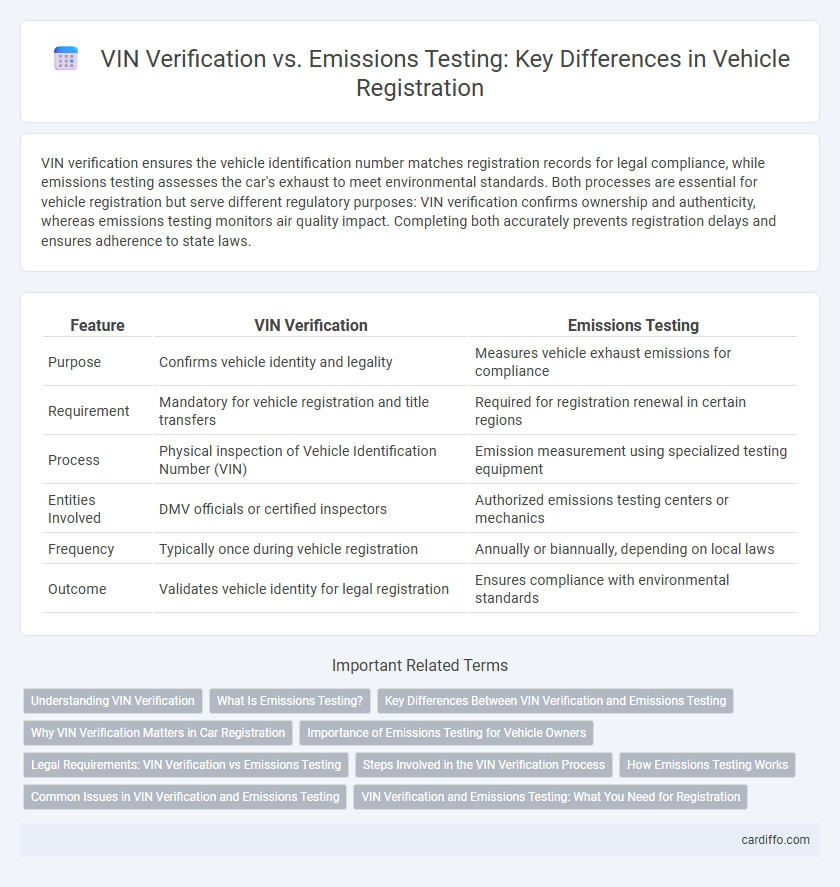VIN verification ensures the vehicle identification number matches registration records for legal compliance, while emissions testing assesses the car's exhaust to meet environmental standards. Both processes are essential for vehicle registration but serve different regulatory purposes: VIN verification confirms ownership and authenticity, whereas emissions testing monitors air quality impact. Completing both accurately prevents registration delays and ensures adherence to state laws.
Table of Comparison
| Feature | VIN Verification | Emissions Testing |
|---|---|---|
| Purpose | Confirms vehicle identity and legality | Measures vehicle exhaust emissions for compliance |
| Requirement | Mandatory for vehicle registration and title transfers | Required for registration renewal in certain regions |
| Process | Physical inspection of Vehicle Identification Number (VIN) | Emission measurement using specialized testing equipment |
| Entities Involved | DMV officials or certified inspectors | Authorized emissions testing centers or mechanics |
| Frequency | Typically once during vehicle registration | Annually or biannually, depending on local laws |
| Outcome | Validates vehicle identity for legal registration | Ensures compliance with environmental standards |
Understanding VIN Verification
VIN verification confirms a vehicle's unique identification number to ensure its legitimacy and match registration records, which is crucial for preventing fraud and verifying ownership. This process involves physically inspecting the VIN on the vehicle and cross-referencing it with official documents. Unlike emissions testing, which measures exhaust pollutants to meet environmental standards, VIN verification focuses solely on the vehicle's identity and legal compliance.
What Is Emissions Testing?
Emissions testing is a regulatory process that measures the amount of harmful pollutants released by a vehicle's exhaust system to ensure compliance with environmental standards. Unlike VIN verification, which confirms the vehicle's identification number for registration purposes, emissions testing focuses on reducing air pollution and promoting cleaner air quality. This test typically assesses carbon monoxide (CO), nitrogen oxides (NOx), hydrocarbons, and particulate matter emissions.
Key Differences Between VIN Verification and Emissions Testing
VIN verification confirms the vehicle identification number matches the official records, ensuring the car's identity and legal status. Emissions testing measures the level of pollutants emitted to assess compliance with environmental standards and reduce air pollution. These processes serve distinct purposes: VIN verification validates ownership and vehicle accuracy, while emissions testing ensures environmental safety.
Why VIN Verification Matters in Car Registration
VIN verification is crucial in car registration to confirm the vehicle's identity and prevent fraud, ensuring the VIN matches official records. Unlike emissions testing, which assesses environmental compliance, VIN verification validates ownership and legal status, reducing risks of stolen or altered vehicles. This process supports accurate vehicle history tracking and enhances overall registration integrity.
Importance of Emissions Testing for Vehicle Owners
Emissions testing plays a crucial role in maintaining air quality and ensuring compliance with environmental regulations for vehicle owners. Unlike VIN verification, which confirms the vehicle's identity, emissions testing measures pollutants released by the engine to reduce harmful environmental impact. Regular emissions tests help vehicle owners avoid fines, enhance fuel efficiency, and contribute to public health by minimizing toxic exhaust gases.
Legal Requirements: VIN Verification vs Emissions Testing
VIN verification confirms the vehicle identification number matches registration records and is legally required for out-of-state vehicle transfers or salvage title applications. Emissions testing ensures a vehicle meets environmental pollution standards, mandated by state laws to reduce air pollution and protect public health. Both procedures are critical legal requirements in vehicle registration processes, but address different regulatory standards: identity authentication versus environmental compliance.
Steps Involved in the VIN Verification Process
The VIN verification process involves physically inspecting the vehicle identification number to confirm its authenticity and match it with the vehicle's title records. A certified inspector or DMV official examines the VIN plate, usually located on the dashboard or door frame, and verifies the numbers against the state's database. This step ensures the vehicle's identity is legitimate before proceeding with registration and does not test emissions or environmental compliance.
How Emissions Testing Works
Emissions testing measures the levels of pollutants released by a vehicle's exhaust system to ensure compliance with environmental standards set by regulatory agencies. The process involves connecting a vehicle to an emissions analyzer that evaluates gases such as carbon monoxide, hydrocarbons, and nitrogen oxides while the engine runs at idle or under simulated driving conditions. This testing helps maintain air quality by identifying vehicles with excessive emissions that may require repair or fail to meet state or local environmental regulations during registration.
Common Issues in VIN Verification and Emissions Testing
Common issues in VIN verification include mismatched or illegible VINs, tampered labels, and discrepancies between vehicle documents and physical identification plates. Emissions testing problems often arise from faulty sensors, outdated testing equipment, or vehicles not meeting state-specific environmental standards. Both processes require precise adherence to regulatory guidelines to avoid registration delays or rejections.
VIN Verification and Emissions Testing: What You Need for Registration
VIN verification ensures that your vehicle identification number matches DMV records, confirming the car's identity and preventing fraud during registration. Emissions testing measures your vehicle's exhaust pollutants to comply with environmental standards, which is mandatory for most gasoline and diesel vehicles in many states. Both VIN verification and emissions testing are essential steps in the vehicle registration process to guarantee lawful ownership and environmental responsibility.
VIN verification vs Emissions testing Infographic

 cardiffo.com
cardiffo.com